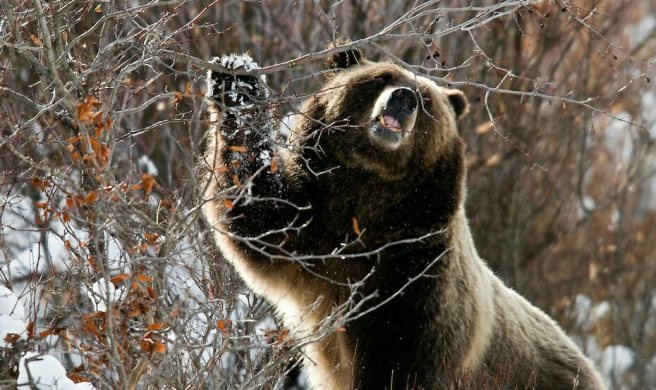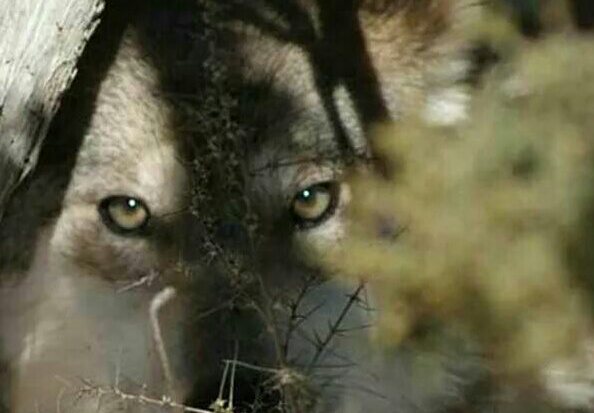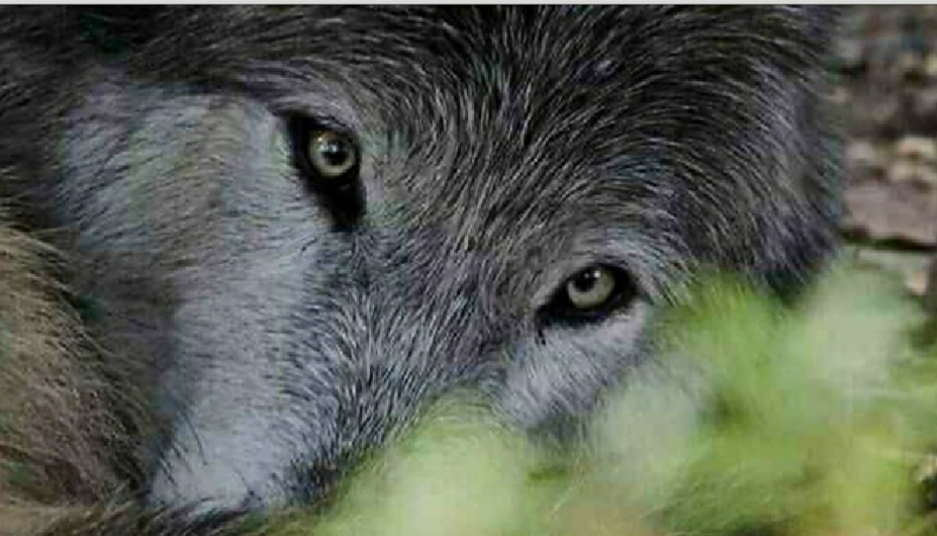Federal delisting and subsequent hunting, as well as the imminent extinction of a key food source, due to global warming, spell disaster for the iconic grizzly bears of the Greater Yellowstone Ecosystem.
Grizzly bears feel the effects of climate change in more ways than just an untimely end to hibernation; as the whitebark pine tree succumbs to the effects of global warming, the grizzlies primary food source (nuts from the tree) is rapidly disappearing with the tree facing possible extinction from the park (80 percent of the stands are dead or dying). Once common in harsh mountain environments, the tree is being pushed out of its sub-alpine habitat thanks to a warming climate, causing the treeline to migrate to higher elevations.
The whitebark pine is also a victim of the pine beetle, the insect responsible for the destruction of hundreds of thousands of acres of forests across the West. Pine bark larvae have higher survival rates in warmer winters and the infestation, at this stage, seems unstoppable (In 2011 the U.S. Fish and Wildlife Service determined the tree warrants protection under the Endangered Species Act). In the Yellowstone park area the tree is nearly gone: “No amount of science or management will bring the trees back in our lifetime.” 
In 2007, this massive die off of whitebark pine trees added hardship to the misery which the Greater Yellowstone Ecosystem distinct population segment of grizzly bear population had to face, as they were removed from the threatened species list, and the “Conservation Strategy” was implemented. Our warming planet’s effect on grizzly bear habitat and food source was obviously of no great concern to Fish and Wildlife when making this choice to delist the Yellowstone grizzly.
FWS argues that whitebark seeds are not a naturally reliable food source, and that grizzlies have been coping for millennia by switching to other foods when whitebark pine seeds are unavailable by consuming other “readily available” foods such as ungulates, ground squirrels, insects, roots, mushrooms, and other vegetative matter. However, what must, and should, be emphasized is the fact that the grizzly bear population increases at a slower rate when the whitebark seed is scarce. It is well documented that good whitebark cone crops decrease grizzly mortality and increase the number of bear cubs per litter. For Grizzlies, one of the world’s slowest-reproducing mammals, this issue cannot be ignored when considering delisting this iconic species.

Directly after removal from protections, in 2008, Grizzlies died in record numbers, there were virtually no penalties for killing them. Bear management had been turned over to fish and game agencies of Wyoming, Idaho and Montana who more than welcome the “opportunity to kill a Grizzly”, a bear whose life was made less valuable by delisting. Some 54 grizzly bears — including 37 shot by humans — were known to have died that year, the highest mortality ever recorded; exceeding the extensive killings of 40 years ago when Yellowstone National Park closed down its garbage dumps leaving the bears to search for food sources in towns and campgrounds.
Thankfully, in 2009, in a strongly worded order, U.S. District Judge Donald W. Molloy, overturned the delisting ruling, placing grizzly bears back on the threatened species list claiming: (1) the Conservation Strategy was unenforceable, and (2) that the U.S. Fish and Wildlife Service did not adequately consider the impacts of the potential loss of whitebark pine nuts.
As if we hadn’t learned our lesson from prior grizzly strategies, we find ourselves at the crossroads of further endangering the very existence of our beloved Grizzlies by delisting a species struggling to survive in our ever-changing and warming world. Further complicating the situation (as if it wasn’t bad enough, already) the Yellowstone grizzly bear population suffers from increasingly fragmented and disconnected habitats, according to a report released by the Endangered Species Coalition, which highlights ten rare or endangered species that lack safe, navigable corridors to connect them to important habitat or other populations. Without wildlife corridors, migration routes, and other connected habitat, wildlife like grizzlies cannot continue to reproduce, find food, disperse, and maintain enough diversity in their populations to survive into the future.
Before I continue, let’s take a moment out to watch and enjoy a Yellowstone National Park Grizzly Bear Mother and her cubs on Vimeo.

Delisting Grizzlies in the face of undeniable threats to the bear’s future as a species is hardly a decision based on sound science. Turning the bears’ management over to the fish and game agencies of Wyoming, Idaho and Montana, who not only accept practically any hunter explanation (self-defense or otherwise) for taking a grizzly but who find it perfectly acceptable to “euthanize” a 13 year old mother grizzly, who had cubs by her side for eating apples from a tree! The officials in Idaho determined the adult bear had become “habituated to human-related food”.
And what of Grizzly 399, an elderly 20 year old grizzly, who has brought joy to countless park visitors, famous for tolerating people and for teaching her cubs how to live amicably near roads and developed areas? What will happen when 399 and other park bears lose their Endangered Species Act (ESA) protections—possibly as soon as this spring—when the states of Wyoming, Montana, and Idaho jump at the opportunity to implement a “sport” hunt that could kill as many as 30 bears in the next year alone? I shudder at the thought of the betrayal these bears will face. From Counterpunch:
“The first bears to be killed in a trophy sport hunt are likely to be celebrities such as Grizzly 399 that make their living along roadsides in Grand Teton and Yellowstone Parks, where they give thousands of visitors the thrill of a lifetime. These tolerant bears, which live partly on National Forest lands outside parks, would be especially vulnerable to hunting if federal protections are lifted later this year. These bears are comfortable with people and would be relatively easy to find. Moreover, certain local thugs have stated outright that they will be out to kill these much-beloved grizzlies—out of spite.”
With the quality of grizzly habitat eroding due to global warming, and whitebark pine nuts almost completely eliminated from grizzly bear diets, grizzlies in this island ecosystem will be severely stressed. Yellowstone grizzlies will require more public land to roam, not only for “readily available” food sources but also so they can maintain genetic diversity by breeding with other grizzly bear populations.
The most important move the government could make (other than an effective plan to help people and bears avoid conflicts) would be to keep the grizzly population of Yellowstone protected under the ESA.
Please submit your comment against removing ESA protections for the grizzlies of the Greater Yellowstone Ecosystem here. Please note that submissions merely supporting or opposing a potential delisting, without supporting documentation, will not be considered in making a determination.
Comments are due May 10 2016, at 11:59 PM Eastern time.
Please sign these petitions:
Protect Grizzly Bears in Idaho, Montana and Wyoming
Keep Yellowstone Grizzlies Protected under the ESA
Don’t kill protections for Yellowstone Grizzlies
Help protect grizzly bears in the Greater Yellowstone Ecosystem!
Protect the Greater Yellowstone grizzly– Stop the delisting!
Facebook pages devoted to Yellowstone bears: Hey Bear | GOAL Tribal Coalition and Greater Yellowstone Bears. Also reach out to Campaign for Yellowstone’s Wolves who will be holding rallies this summer for the benefit of the park bears and wolves.
.@USFWS @DirectorDanAshe Please maintain Endangered Species Act protections 4 #GrizzlyBears #DontDelistGrizzlies pic.twitter.com/PRsBST6s4w Send a tweet for grizzlies
All images used in this blog post are of Grizzly 399 and are by Bradly J. Boner (with the exception of the vimeo)
Op-Ed by Doug Peacock who has been writing and lecturing about Yellowstone bears for more than 40 years.

Copyright © 2015 [COPYRIGHT Intheshadowofthewolf, name and webpage]. All Rights Reserved.
No part of this publication may be reproduced or distributed in any form or by any means, or stored in a database or retrieval system, without the prior written permission of the publisher.



You must be logged in to post a comment.